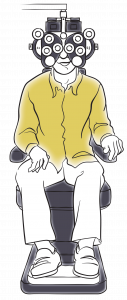 Seeing an optometrist every year is a simple yet important step you can take to prevent vision loss from diseases. Yet with an estimated 61 million adults in the United States at high risk for vision loss, only half of them visited the eye doctor within the past twelve months.
Seeing an optometrist every year is a simple yet important step you can take to prevent vision loss from diseases. Yet with an estimated 61 million adults in the United States at high risk for vision loss, only half of them visited the eye doctor within the past twelve months.
Even if you do not believe that you currently need corrective lenses or that your current prescription is adequate, it is still necessary to see your optometrist annually for a routine eye exam. And the benefits from these checkups extend beyond that of eye care and vision correction.
During the exam, your optometrist may perform a dilated eye test, depending on your age and health. This allows them to detect glaucoma and other eye conditions, plus chronic conditions such as high blood pressure, high cholesterol, cancer, and diabetes. Early detection results in a better prognosis for the patient and is likely to reduce incurred costs.
If you begin having problems with your eyesight, don’t wait until your next visit to mention it – make an appointment with your optometrist as soon as possible. Decreased vision, double vision, eye pain, “floaters”, and other vision problems can be an indication of a much larger issue (or even a detached retina… ouch!).
Lastly, if you have kids, make sure they get yearly exams, too. Good vision helps children succeed in the classroom and at sports and other activities.
Keeping Your Eyes on Health — Decreased vision is part of aging, but there are ways to help keep your eyes healthy:
- Eat healthy. Nutrients such as omega-3 fatty acids can help ward off age-related vision problems.
- Quit smoking. It increases the chance of cataracts and can damage your optic nerve.
- Look away from the computer screen. Every 20 minutes or so, look at something around 20 feet away for about 20 seconds.
- Maintain a healthy weight. An active lifestyle reduces your glaucoma risk.
- Wear sunglasses when outdoors in the daylight. Sunglasses should block 100 percent of UV rays.
- Use safety eye wear. If you use hazardous or airborne materials, wear safety goggles or glasses.
